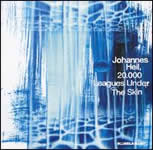|
|
 |
Dusted Reviews
Artist: Johannes Heil Album: 20,000 Leagues Under The Skin Label: Kanzleramt Review date: Oct. 22, 2003 |

|
|
|
 |
With a plethora of great 12” singles to his name (specifically Eye Of Providence and Paranoid Dancer), Johannes Heil has proven himself to be a mainstay of Heiko Laux’s Kanzleramt label and along with Alexander Kowalski has allowed the label to keep apace with such heavyweight compatriots as Kompakt, Raum, and Playhouse.
Split up into twelve parts, 20,000 Leagues Under The Skin would appear to be Heil’s first true attempt at epic-length armchair techno, as his past albums were less cohesive and rather single-oriented. Yet, the fact that the CD and vinyl versions of Leagues offer different material of the epic leaves the impression that Heil’s vision of Leagues is far from cemented. Further confusing matters, the track listing of the disc is out of sequence, leaving it up to the listener to rearrange the tracks in the proper manner.
In the end, no amount of track arranging can save Leagues from mediocrity. The disc’s opening track, “Part Four” is pleasant enough, blending early Warp material with a jazz organ that is buried in the mix, a la Compost. “Part One” (track 10 on the disc) fails to set any sort of mood with its generic pseudo-Orb ambient posturing and proves remarkably anticlimactic at 11 minutes. The shorter tracks have the feel of failed experiments, passing by without intent or merit. The majority of Leagues (“Parts Five, Six, Eight”) is filled with a tribal tech house vibe: High bpm drum tracks accentuated with varying synth and dub effects that run 5-7 minutes in length. These tracks would work wonders as dancefloor fodder at your local kiddie rave, but do not make the cut at home or in any other serious listening environ.
Ironically, the two best tracks are those restricted to the CD – “Parts Eleven” “Twelve”. The gentle rollicking of “Part Eleven” leaves an illusion of still motion in its wake, succeeding in every aspect where “Part One” failed. League’s tribal tech rhythms are toned down immensely for “Part Twelve”, allowing a deeper examination of its surroundings, revealing Ash Ra synth-guitar flourishes with hypnotic intentions.
There has been a massive amount of electronic music produced since the rise of acid house and, because of dancefloor intentions, much of it is of a disposable variety. The work of very few artists merits repeat listening, lacking the depth, talent, and vision to endure. Heil had an admirable impulse in attempting to produce a work of such magnitude, but in a genre that virtually consumes its old and young for lunch, there is no room for mediocrity.
By Everett Jang Perdue
|







